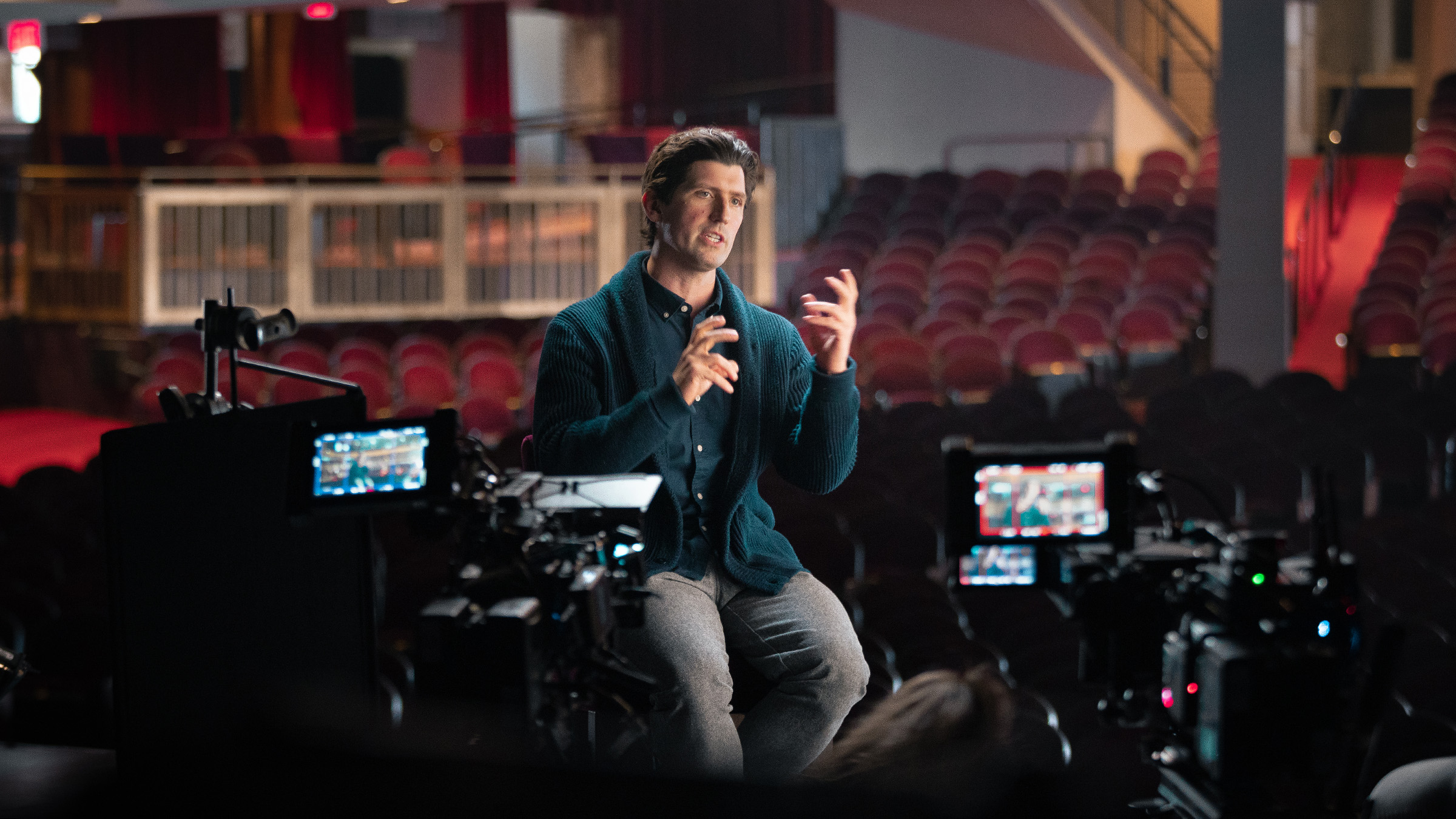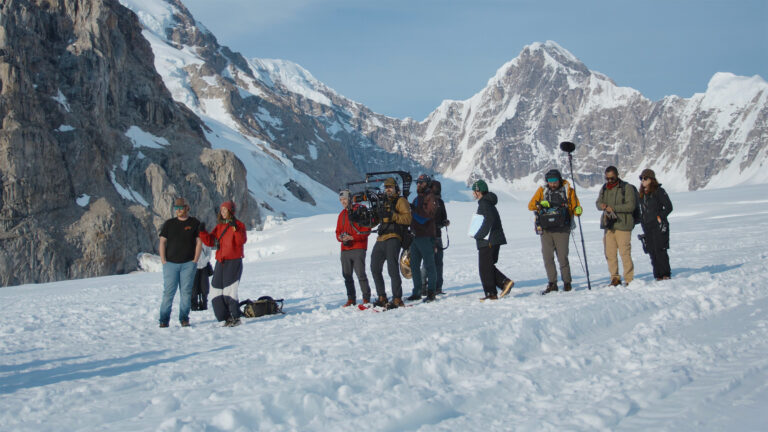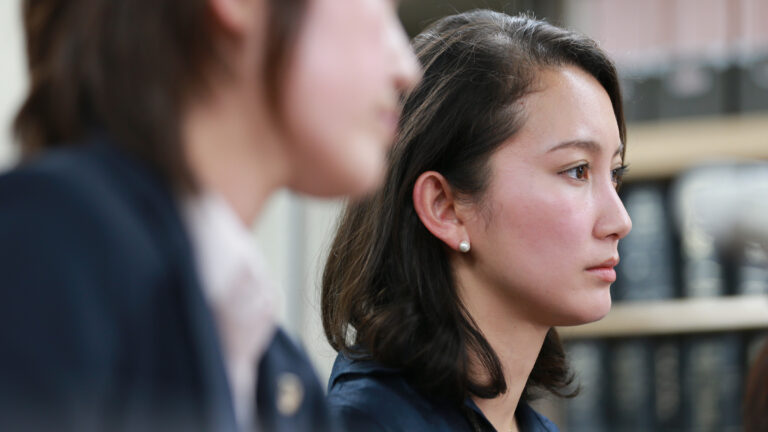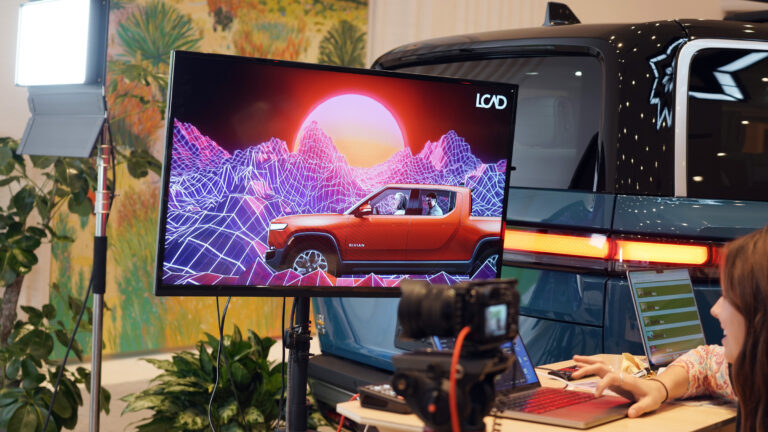A chance meeting at the Berlin airport brought renowned actor-comedian Bill Murray and classical cellist Jan Vogler together in 2013.
What began as a friendship grew into a creative partnership that yielded an eclectic live musical performance titled New Worlds: Bill Murray, Jan Vogler and Friends. From the Acropolis in Athens through a global pandemic, it’s taken years for an intrepid group of filmmakers to document this limited-run event.
In this installment of Made in Frame, we’ll give you a glimpse into the creative forces and process that took the show from the stage to the screen in New Worlds: The Cradle of Civilization.
Old meets new
New Worlds is the melding of classical and more recent works of music and literature, creating something delightfully accessible to modern audiences.
With music from Schubert and Ravel, Murray reads literary passages by James Fennimore Cooper and Hemingway. He also performs songs from Stephen Foster to Stephen Sondheim, Tom Waits, and Bruce Hornsby.
If that sounds dry, it isn’t. Murray is by turns serious and silly, but is always completely captivating, and the brilliant musical trio—Vogler on cello, violinist Mira Wang, and pianist Vanessa Perez—are clearly having just as much fun performing with him as the audience is while watching the unforgettable spectacle.
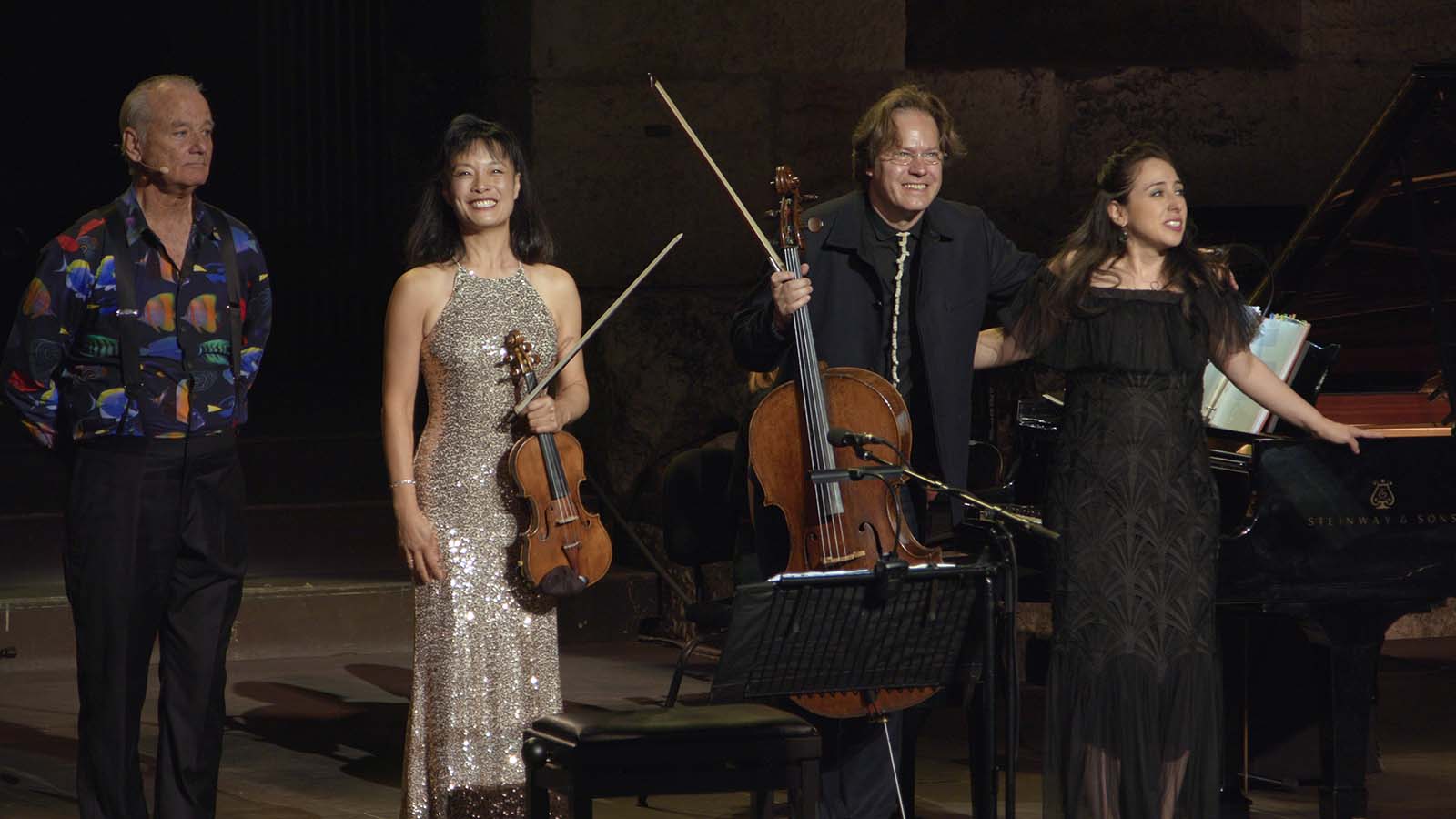
During 2017 and 2018, the quartet performed in venues across the world from Carnegie Hall to the Sydney Opera House, from Dresden to Reykjavik. None of those performances were filmed.
But director Andrew Muscato thought that it should be. “I’d seen the show at Carnegie Hall and then again in California and I kept thinking that it would make a great film,” he says.
“I’d brought it up to a mutual friend of Bill’s and mine, Karen Duffy [one of the film’s producers], and she asked him if he realized that they were doing the final show at the Acropolis. She suggested that it would be an amazing venue for filming, and recommended me to direct.”
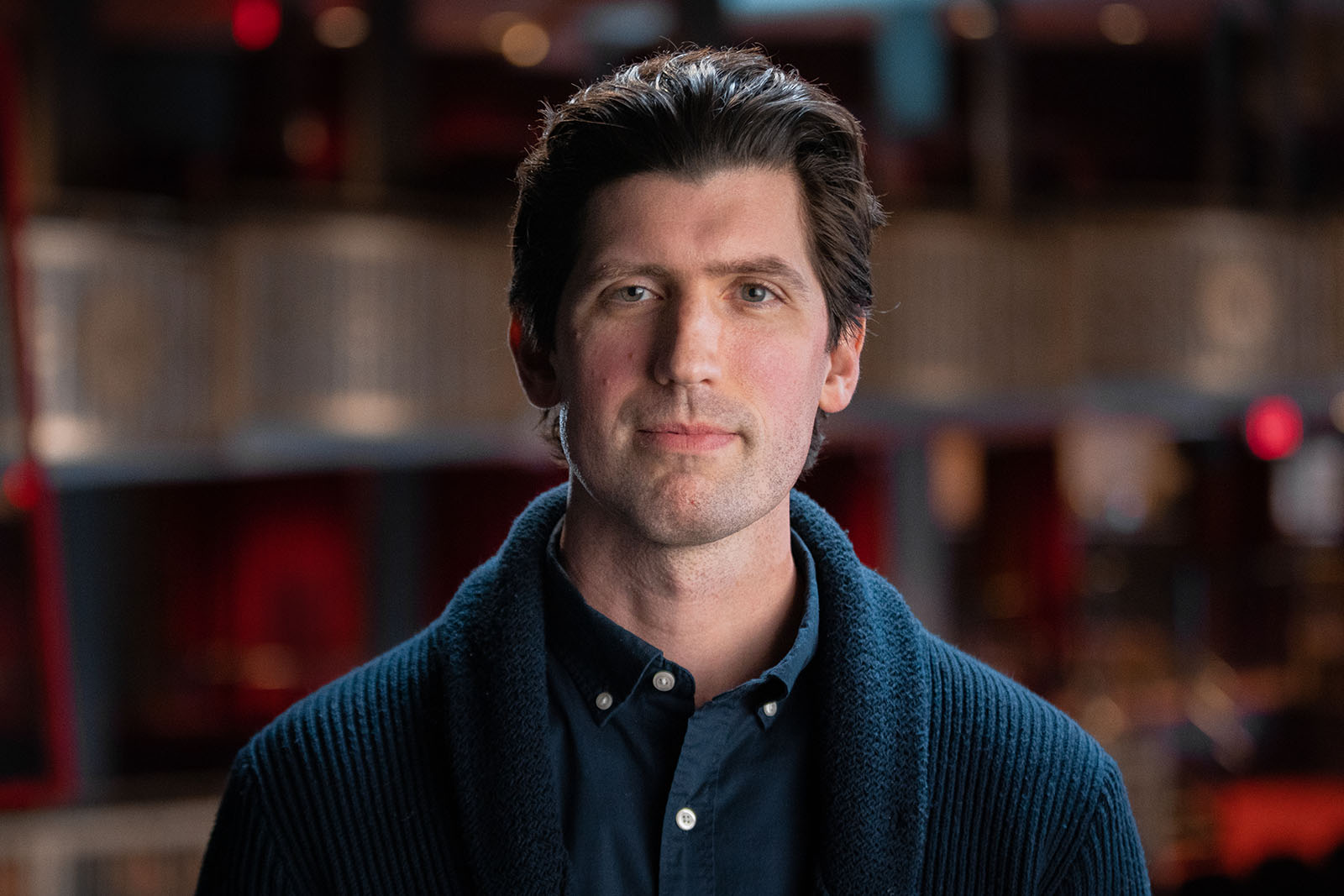
Tight schedules and historic venues
Scheduled for June 19, 2018, at the Acropolis of Athens, Andrew received the green light, in the form of a text from Murray, a very short two weeks before the performance.
The first challenge? Getting the necessary permits to shoot at one of the most important historical locations on the planet. “I’d been to the Acropolis previously as a tourist and had met a lot of film people in Athens during that trip,” Andrew says.
“Amanda Livanou, our producer there, was on the phone with me, telling me that she didn’t think we’d be able to get the permits from the Ministry of Culture and the Archeological Ministry in time. It was like something out of a movie. While we were talking, I got an email that was all in Greek. I sent it to Amanda, and it said the permits had been granted!”
The Odeon of Herodes Atticus, the stage for New Worlds.
The small team had to assemble an extensive camera and lens package, and hire a local crew. DP Mike Gomes, a frequent collaborator of Andrew’s, explains that they had to find six of the same cameras to cover each of the performers and the angles they needed. Because this was all to be shot during a single evening, they had only one chance to capture the performance.
Mike ended up renting six Canon C300 Mark II cameras and “dried up the supply of Angenieux lenses in Athens,” he says. “There were literally no more anywhere.”
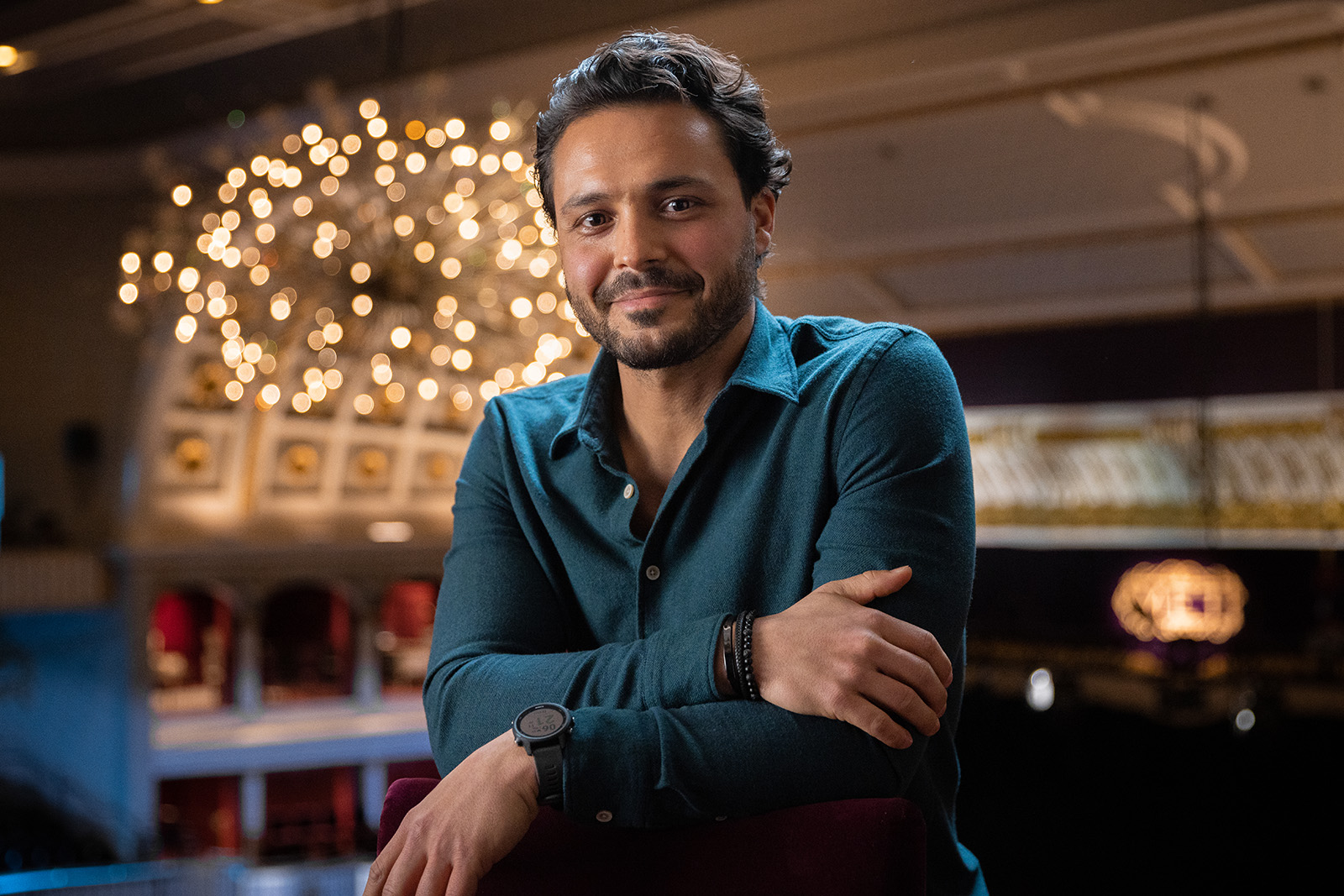
“We had experience with the C300s, which are great,” Andrew says. “I especially appreciated Mike’s emphasis on putting good glass in front of the cameras and we got some really good zoom lenses.”
With the performance scheduled for Tuesday, Andrew and Mike hopped on a flight and arrived in Athens the Friday before to scout the venue.
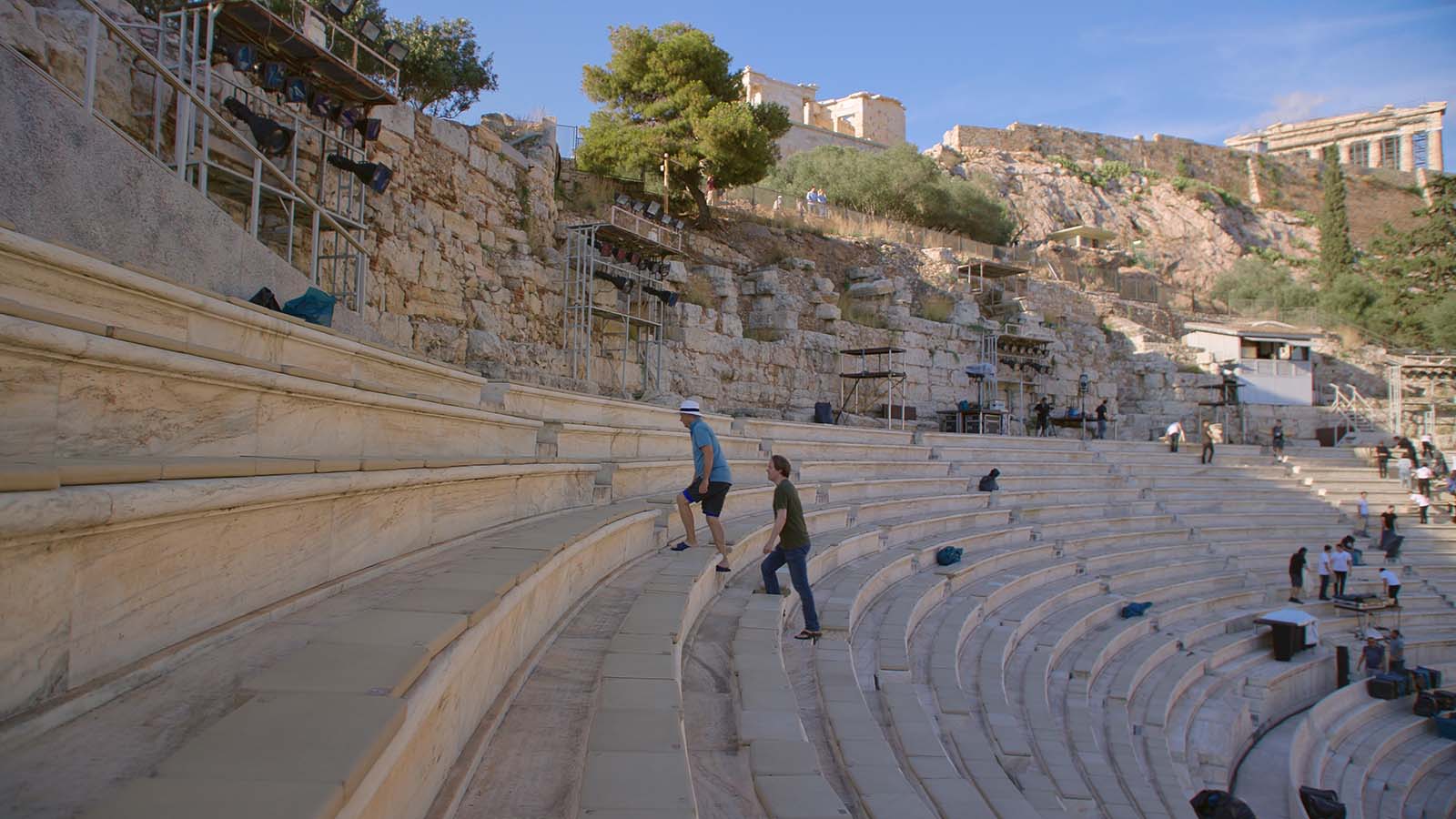
“It’s a protected space, so we had to negotiate where we were allowed to place our cameras,” Andrew says. “We were limited in how many handheld cameras we could have. Mike was our handheld-camera operator on the wings and the backstage area of the stage, and then we had five stationary cameras placed throughout the theater.”
One of Mike’s major concerns was the distance from the camera to the stage. “I needed to make sure that my focal lengths were long enough to get a closeup of Bill and see how tight we could get on the musicians because the distance was significant. I needed as long a focal length as I could get.”
His Angenieux lens package included two 24-290mm lenses; two EZ-1 30-90mm (of which one was converted to 45-135mm); one Optimo 15-40mm; one EZ-2 15-40mm; and one Optimo 28-76mm with a 2x extender.
Mike and Andrew also decided to add a GoPro to their camera package, which allowed them to capture an angle that would have otherwise been impossible to get. “I was glad we mounted one to the piano to see the keys and the crowd in the background,” Mike says. “We could capture moments of Vanessa playing even from behind this massive piano.”
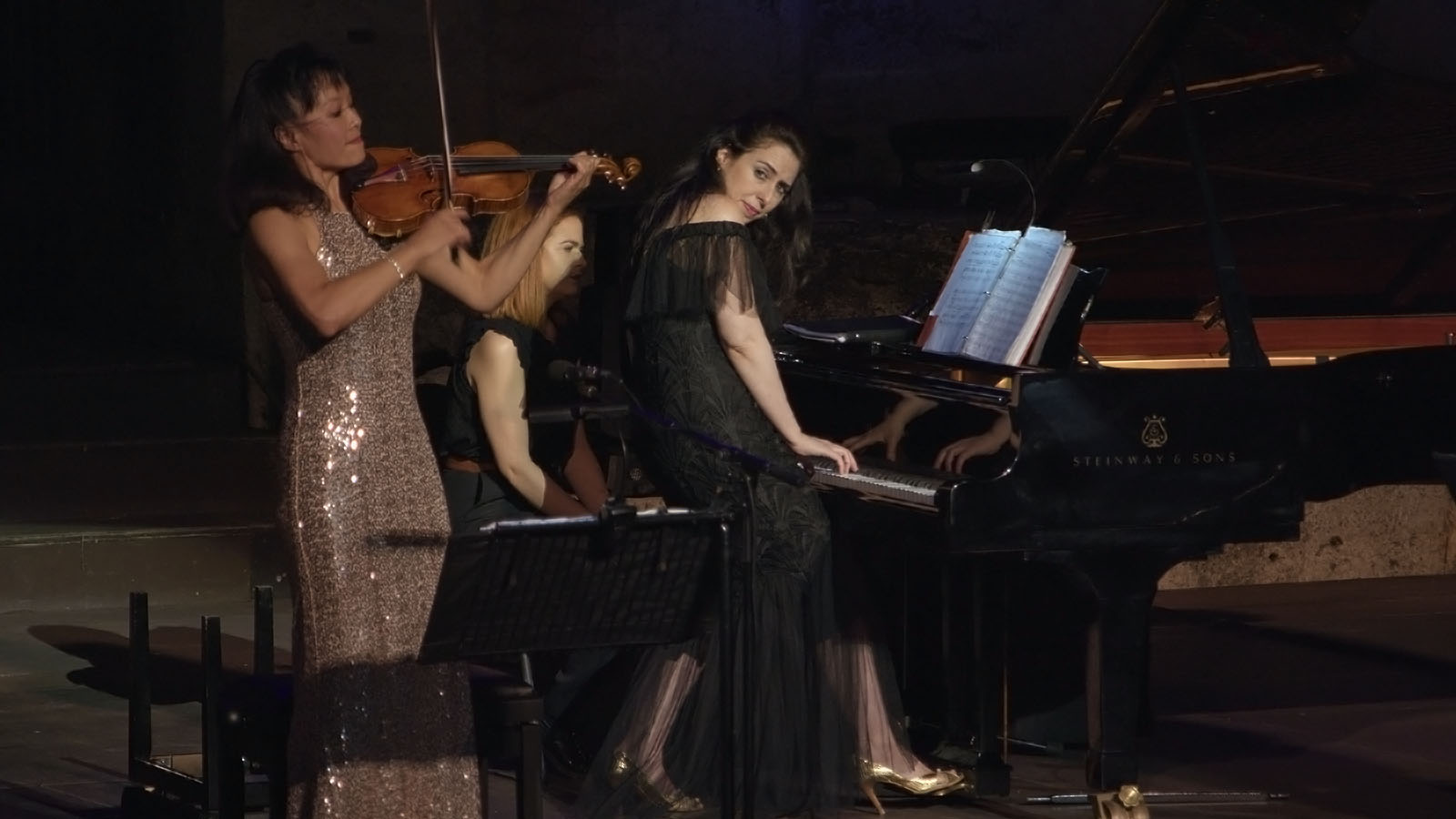
In addition to being respectful of the venue, the team also very thoughtfully took the audience’s experience into consideration. “Part of the challenge was placing the cameras in a way that didn’t interfere with the people who had already bought their tickets and were trying to enjoy the show,” Mike says.
Preparation and the film gods
Given the extremely limited prep time, Mike and Andrew prepared a detailed manifesto for the other camera operators.
“What I was trying to avoid was a group of operators showing up on the day and we get in a semicircle, and I’m telling them each what they need to do, because that is way too last minute,” Mike says.
“On the day, it’s all about execution. So Andrew and I put together an 11-page document, with an overhead diagram with camera positions and who’s covering what so that every camera operator knew where he was placed at the venue, which direction they’re facing, which lens that camera has, along with a couple of reference frames to give them an idea of what we were looking for. I just wanted it to be a very self-explanatory blueprint so that when it was the shoot day, it was just about executing.”
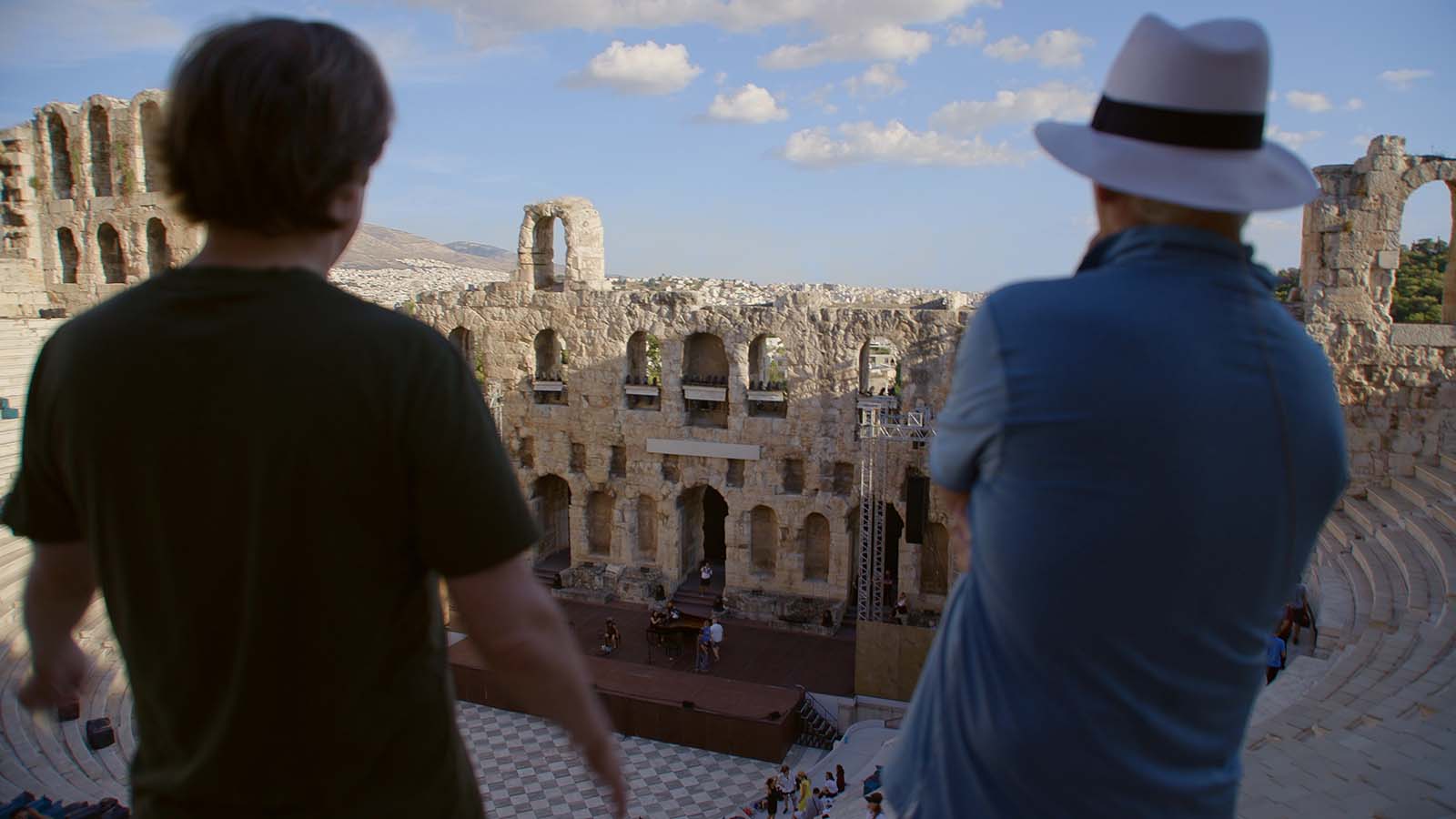
A typical concert film is captured over the course of several shows, or across a tour. But in keeping with the atypical nature of this production, the team had exactly one performance to get what they needed. In a way, this made it even more of a documentary experience.
“I was giving the camera operators instructions over a walkie-talkie as far as what the setup was for each piece, whether it was piano and violin only, or just Bill so the camera operators were able to anticipate what was coming next,” Andrew says. “Each one had an assignment as to what kind of framing they should be shooting, but there was never any specific camera direction of when to pan or tilt or zoom in or out. We were just relying on their instincts.”
The team’s preparation paid off. “Having the blueprint gave us a fighting chance at making sure we were properly covered,” Mike says. “Then the rest was up to the film gods to help us.”
Athena must have been cheering the team on from the Parthenon. There were no technical glitches during the show, and the performances they captured give the viewer of the finished film a similar experience to the actual audience members—and to the quartet itself.
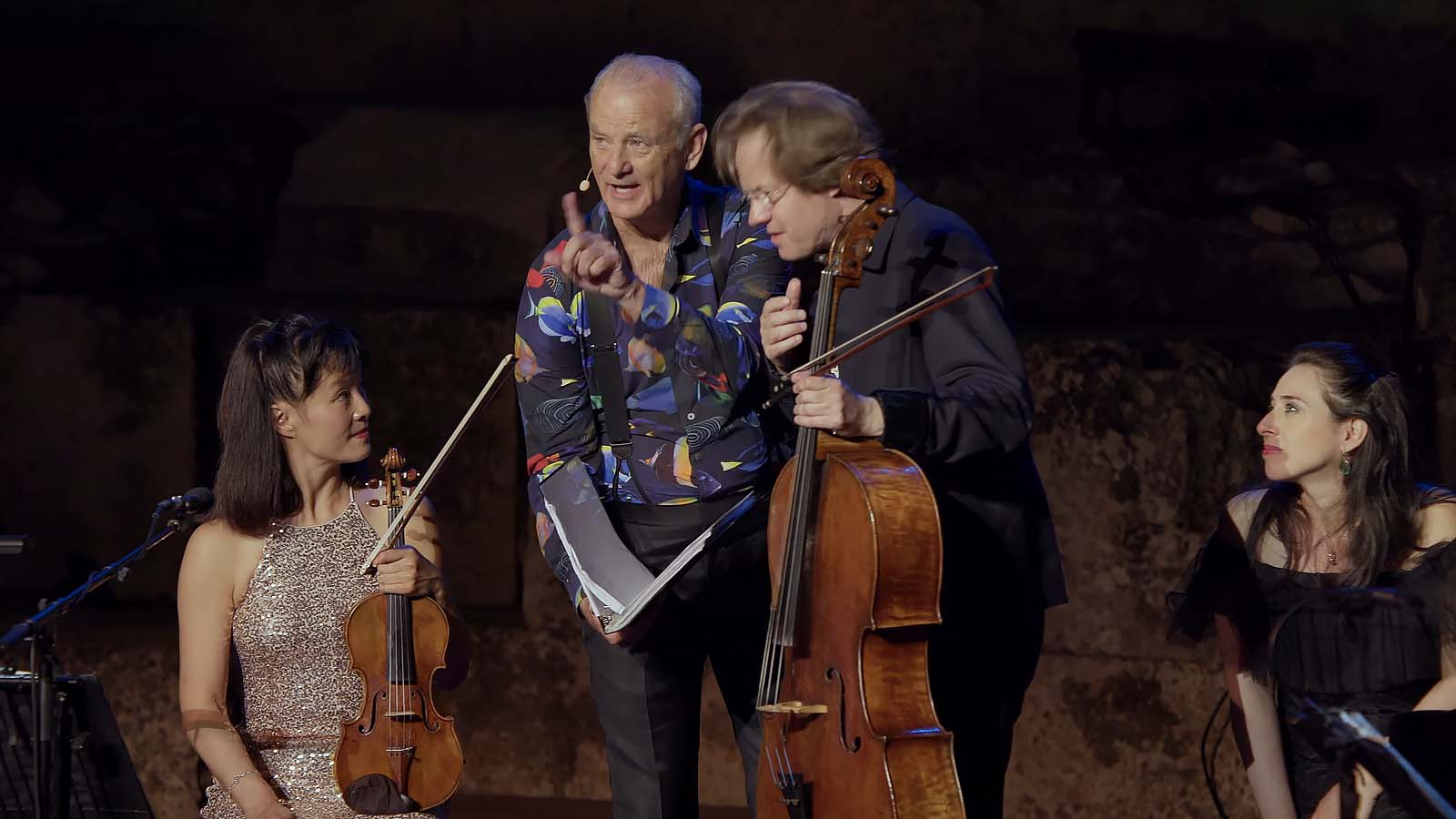
When you have a performer like Murray, who claims to never deliver a number the same way twice, there are always surprises. Watching the three musicians react, laughing with obvious joy, to his unrehearsed dancing and capering around the stage, the effect is all the more intimate and spontaneous.
The team even managed to capture a gorgeous number in which Murray tangos with the violinist on the marble floor to a piece by Astor Piazzolla.
“On the day of the performance, during the soundcheck, Bill spotted the massive marble floor that separated the stage from the audience,” Andrew says. “He said something like, ‘It would be a shame to waste a 2,000-year-old marble floor.’ So Mike was able to get into position to film that, along with the part where Bill goes down to the audience with a big bouquet of roses and hands them out.”
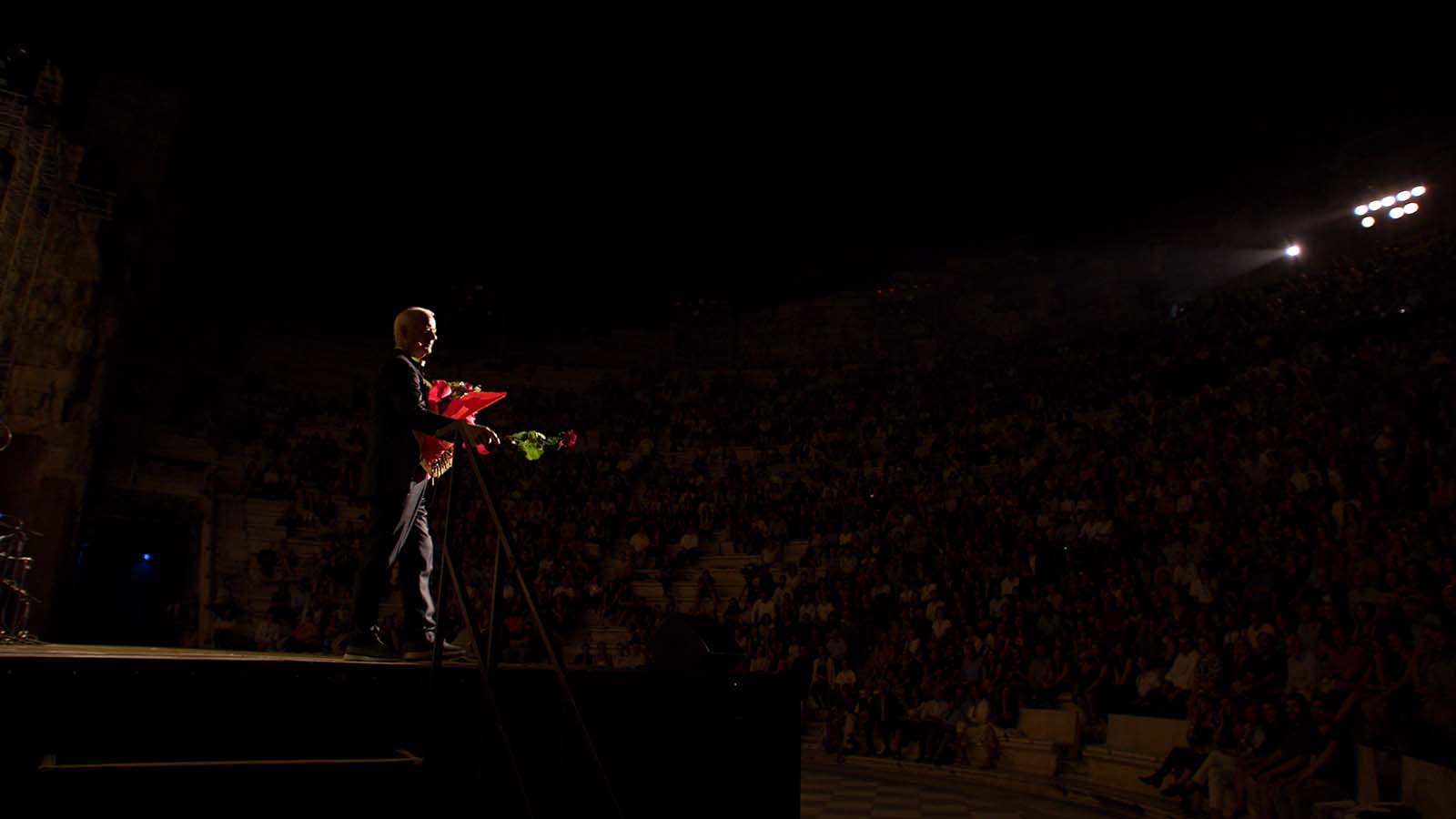
Hurry up and waitNaturally, after a shoot like that the team couldn’t wait to see the dailies.
“The day after the performance I was flying out and I remember being at the Athens airport on the floor on my laptop with the drive plugged into the wall,” Mike says. “I was in Premiere Pro pulling frame grabs because Andrew had told me that he was going to be with Bill and it would be great to have something to show him. So I was, like, ‘Okay, let me pull some frames,’ and I exported one or two takes of a continuous shot of me just roaming around the stage when they were rehearsing so that he had something to show Bill before I boarded my plane.”
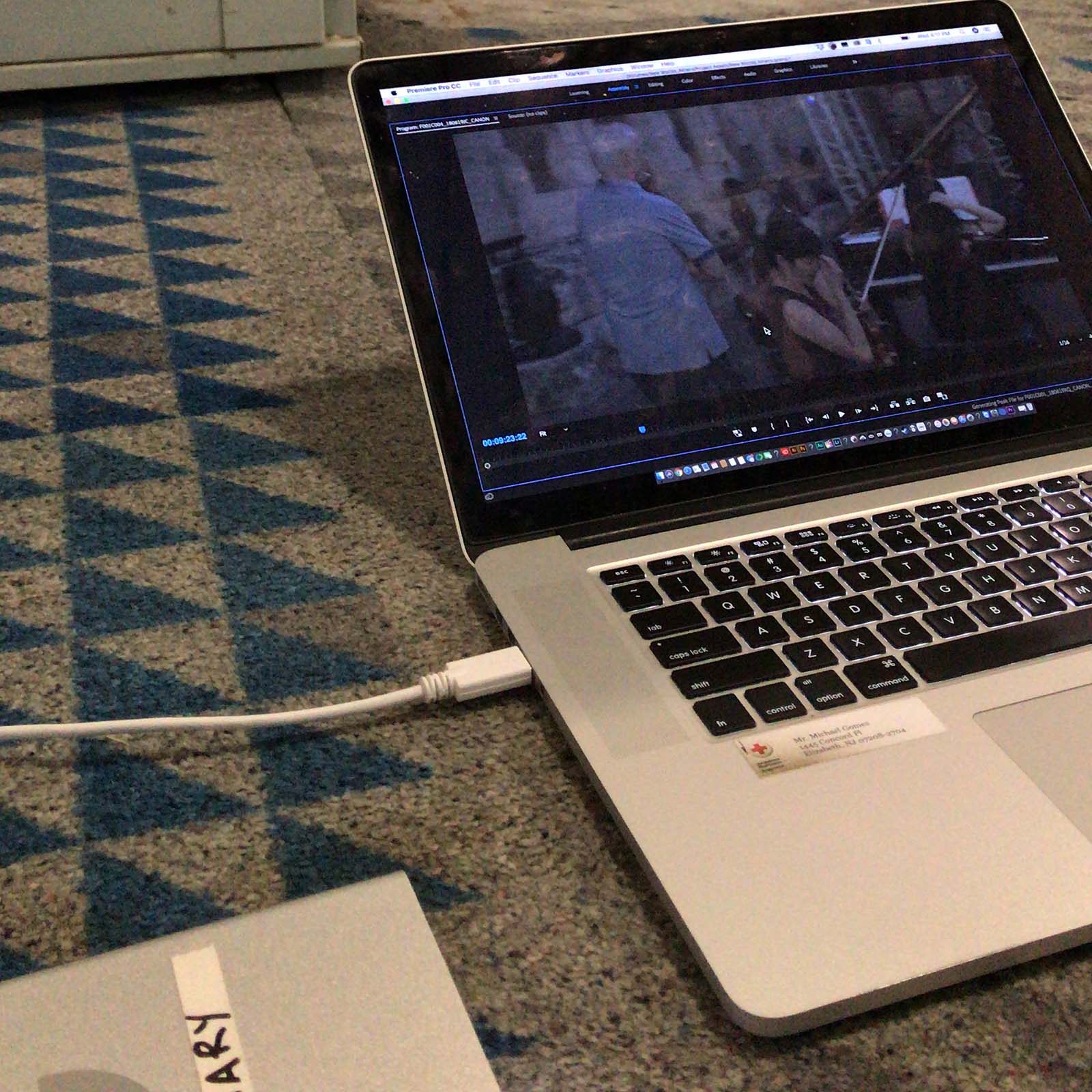
That was on June 20, 2018. But even with the footage in the can, the future of the film was still uncertain. The quartet might have decided to continue touring, or do some kind of theater residency.
Andrew, a longtime Adobe Premiere Pro user, finally decided that during the week between Christmas and New Year’s of 2018, he’d cut a sizzle reel to show to Murray and the rest of his colleagues.
“I cut a two-minute trailer, that’s now actually the movie’s trailer, on my MacBook,” he says. “I wanted them to get excited about what we’d gotten and show them that it could be made into a really cool film.”
But even then, it took another year before Andrew watched all the footage.
“The footage basically sat on the drives for about a year. I didn’t really want to get my hopes up, so now that I think back, I didn’t really roll through everything until late in 2019, when Bill became very interested in seeing a cut.”
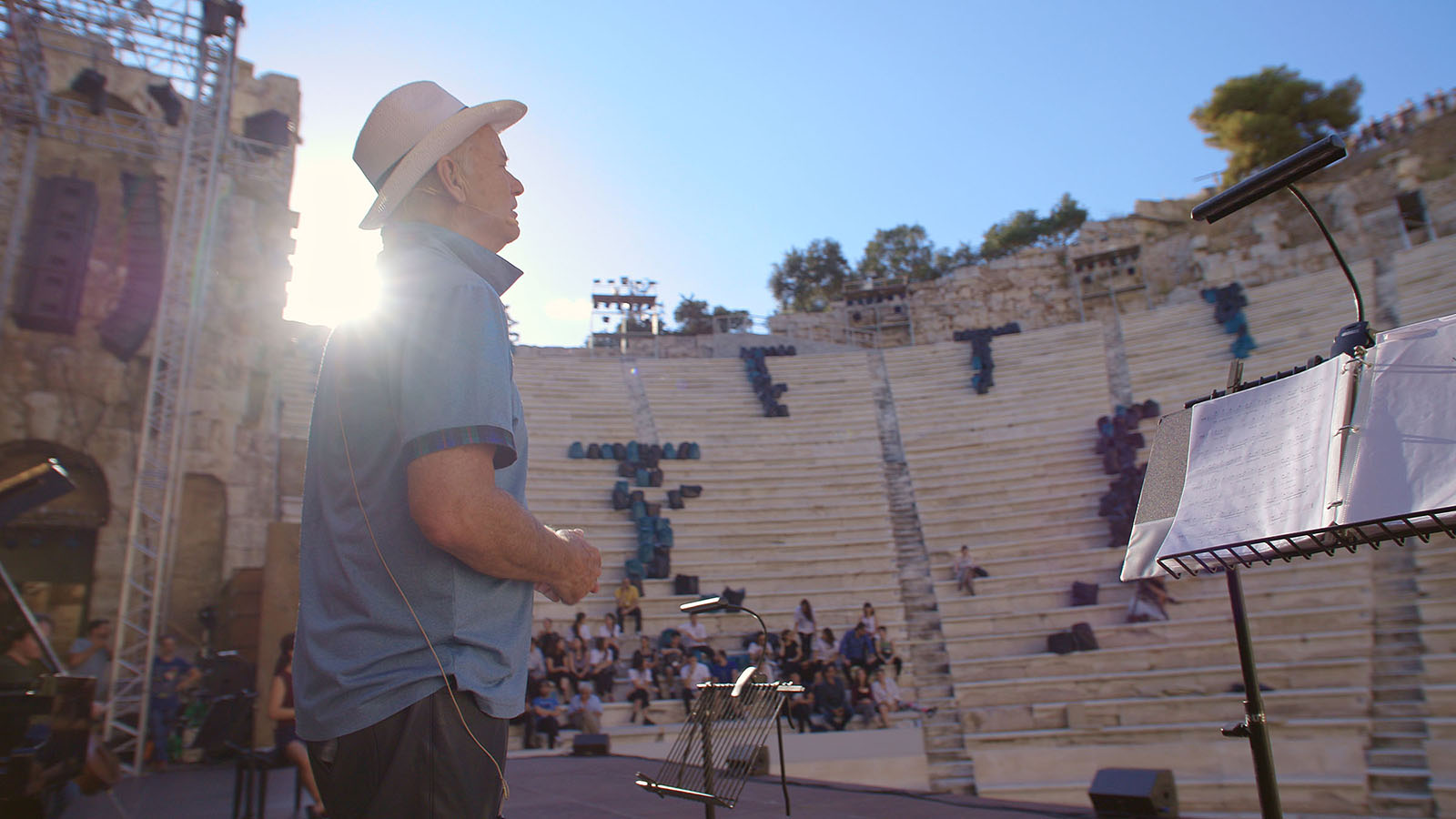
Technology enables creativity
Enter editor Jon Connor. Another documentary- and narrative-feature veteran, he had previously worked on Muhammed Ali: A Life with Andrew and Mike.
Jon’s “weapon of choice” is Adobe Premiere Pro and, like the rest of the team, he’s an OG Frame.io user. He speaks at length about the advantages of using that workflow on a project like this, and its impact both creatively and functionally.
Everything had been shot at 4K (4096 x 2160), and with seven camera angles Jon knew that Premiere Pro was essential to managing the multicam workflow. “First, having the ability to make proxies right inside Premiere and then to be able to just relink to the original files was huge,” he says. “If I remember correctly, I think we used ProRes 422 LT.”
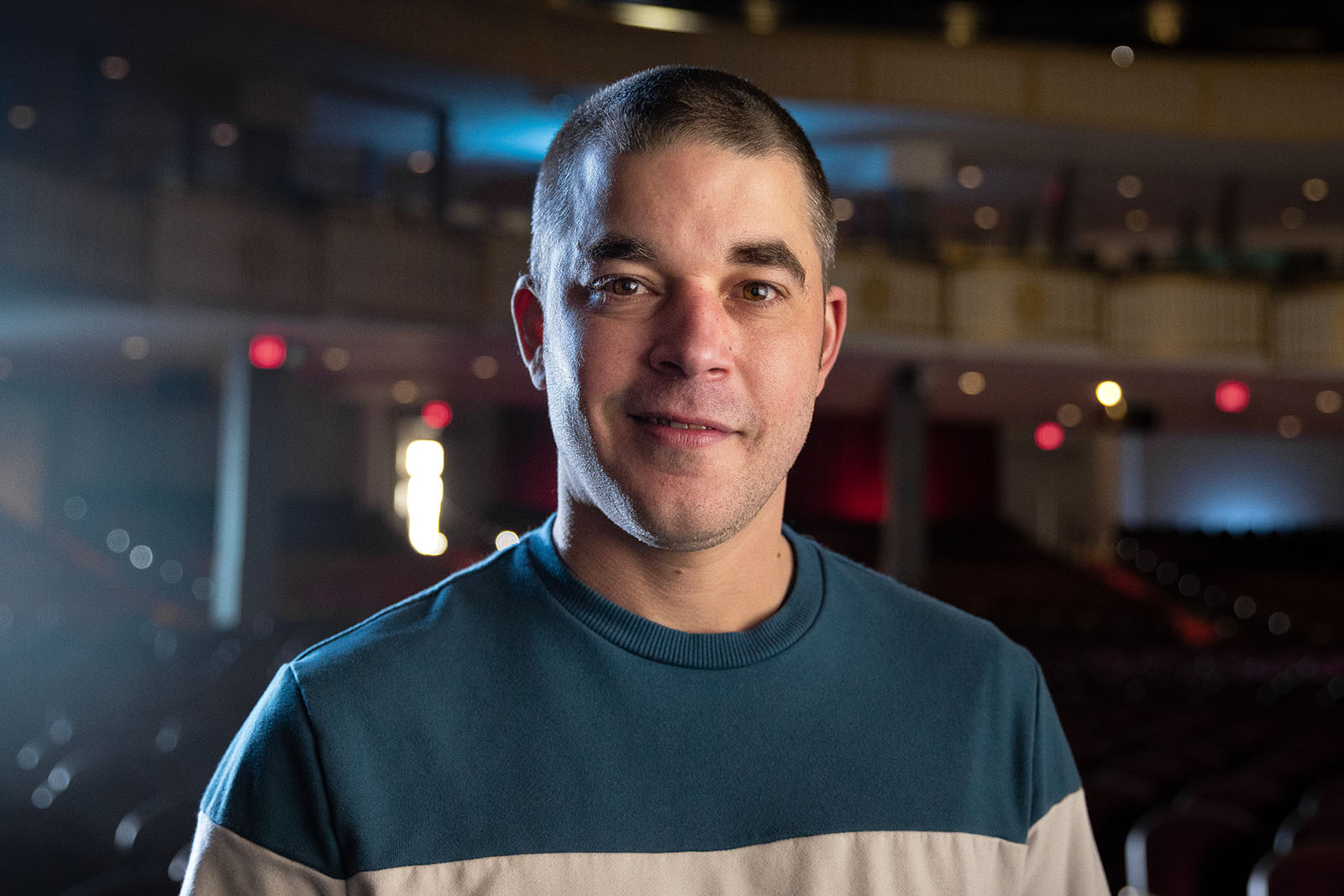
Another feature Jon found incredibly valuable was being able to create a color-coded multicam sequence in Premiere Pro with different label colors to differentiate between the musical numbers. “I could quickly jump forward and backward throughout the film without having to waste time fumbling around trying to find the break in between songs or specific poetry readings,” he says.
“It was a huge time saver and another reason why I love Premiere. Adobe has done a wonderful job of creating an environment for editors where we can quickly move past the technical requirements of editing and focus on what we love to do—which is the creative part.”
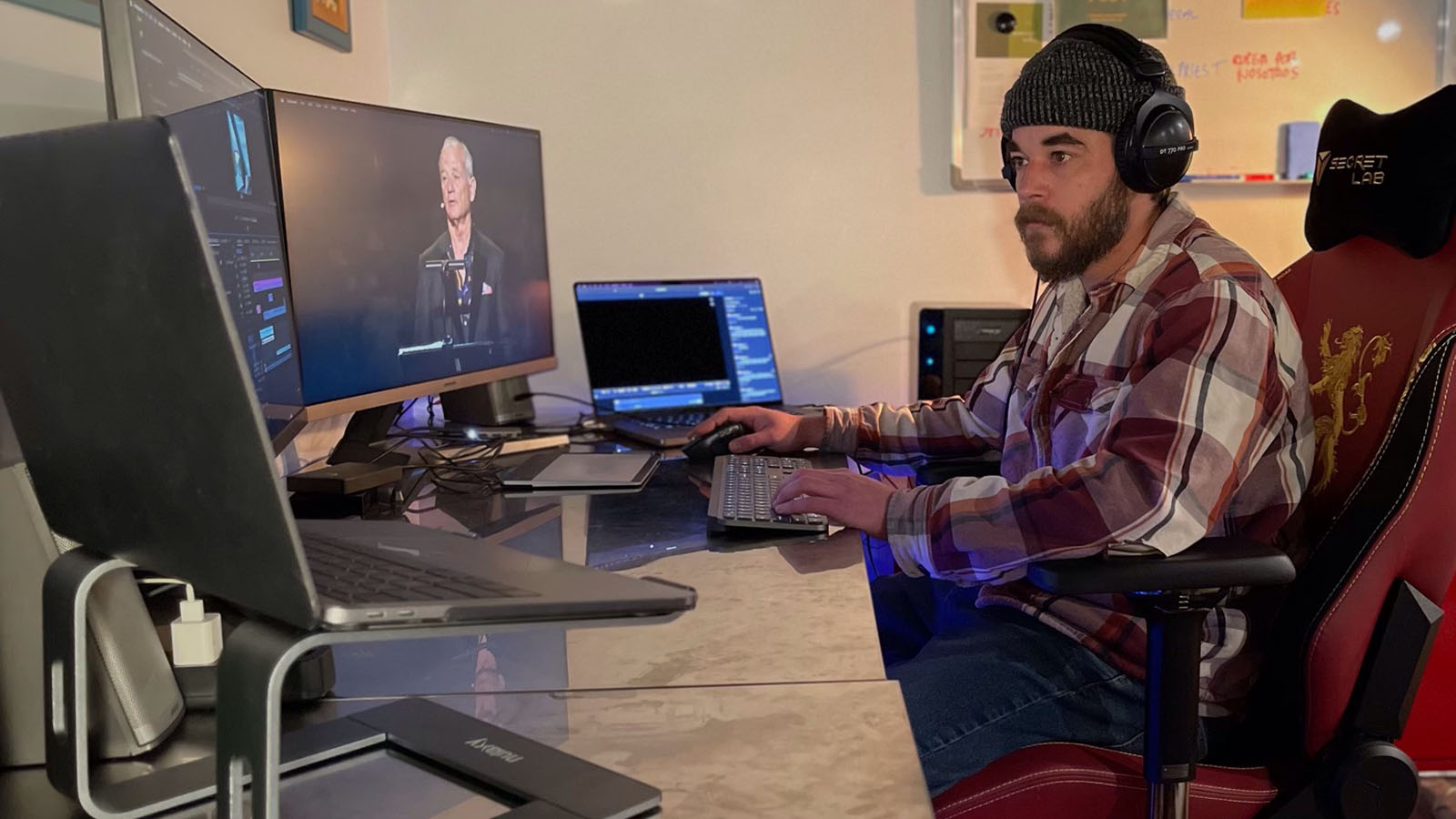
In late 2019 they were ready to show the first cut to Murray. “We went down to Charleston, where Bill lives, in December of 2019, and we screened the assembly for him,” Andrew says. “Then, in January of 2020, we had him up in New York with us and started cutting with him.”
That’s where things really got fun. “I was in the edit suite with Bill and Andrew, and Bill wanted to loosen up the cut and have fun with it,” Jon says. “We’d done a very clean version of it, but Bill said something like, ‘This is Woodstock, baby. Let’s add a little jazz!’”
The team had actually watched some of the iconic concert event videos beginning with Woodstock, but also The Last Waltz, Monterey Pop, and Stop Making Sense. So when Murray gave that note, they knew what he was after.
“We’re always trying to leave out any imperfections, like a camera shake or bump,” Mike says. “But in this case, if the performance was great, we left the imperfections in. He wanted it to feel like there was someone behind the cameras and not just so sterile and perfect.”
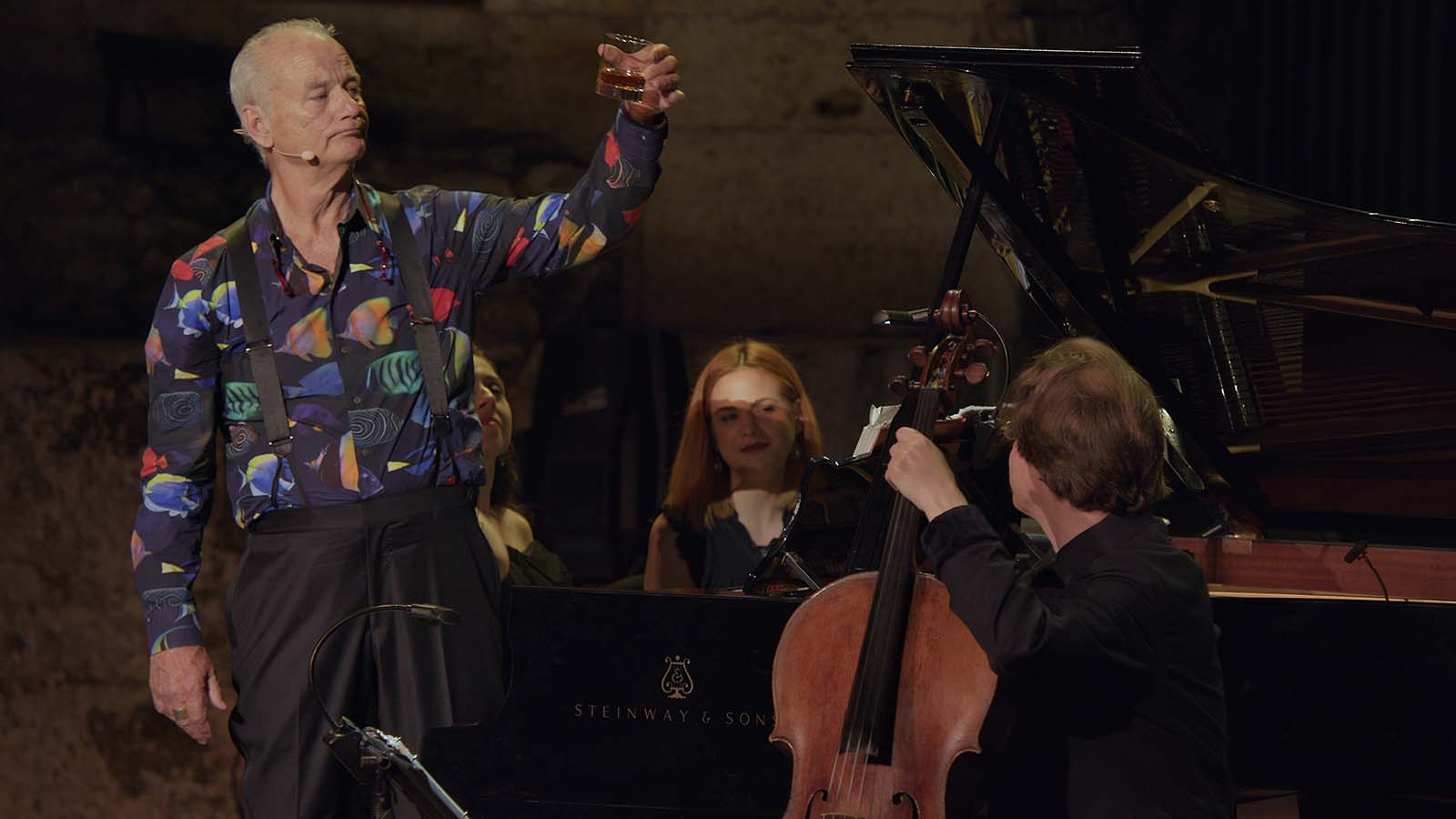
As Jon worked with Andrew and Murray, they discovered a rhythm for experimenting with different camera angles. “It was almost like they were conducting a symphony,” Jon says. “We’d watch a sequence and they’d call out ‘Let me see six,’ or ‘Give me four.’”
This approach was especially evident in the A Moveable Feast sequence, where Murray is acting out several characters, including author Ernest Hemingway, Bulgarian painter Bascin, and two models. As he switches between characters, the team uses different camera angles for each. “It was interesting because we created our own motivation for why we were doing what we were doing,” Jon says.
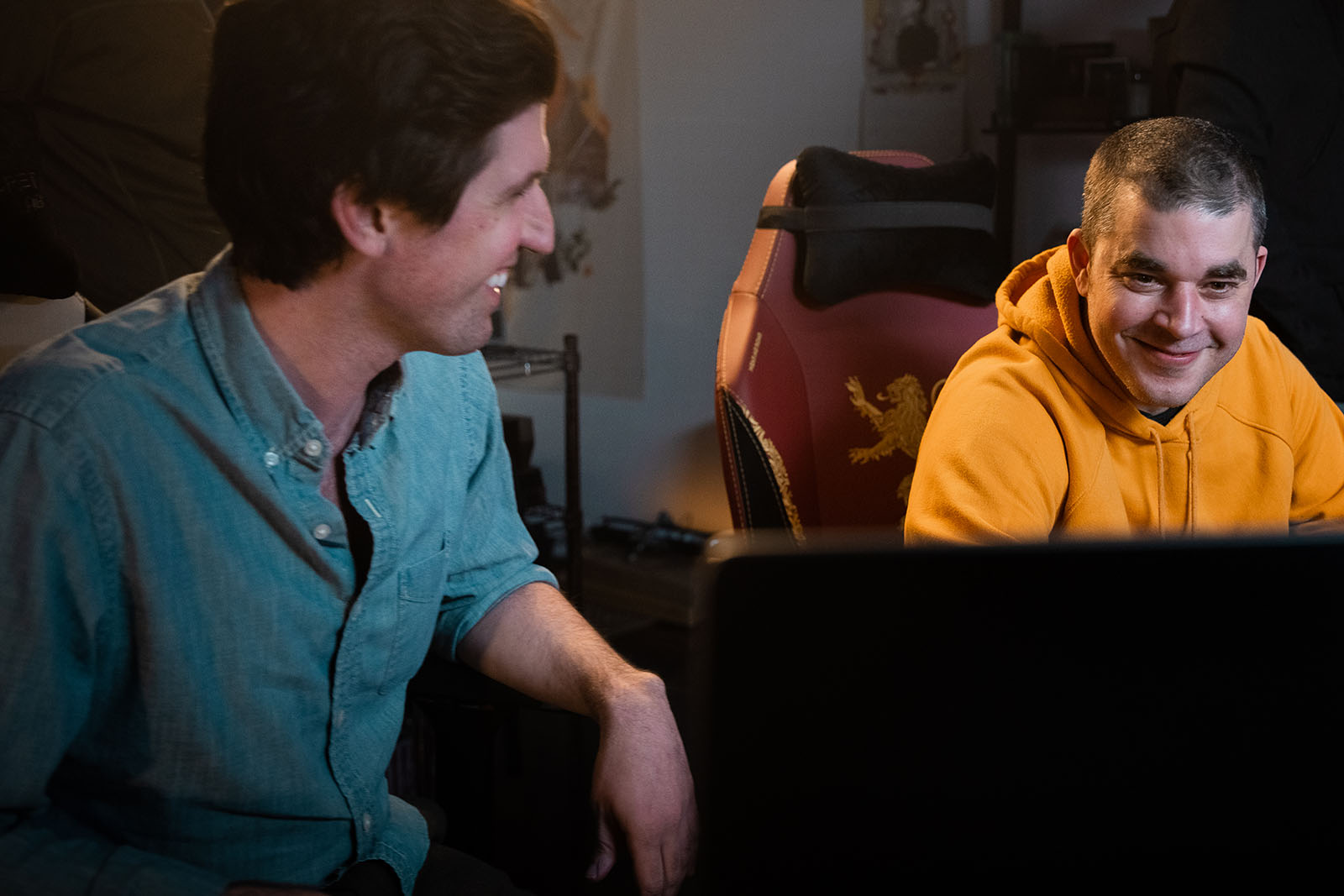
But although they enjoyed the ability to cut spontaneously and dynamically, Murray had some advice that they both took to heart. “Jon and I are of the MTV generation,” Andrew says. “But Bill stays very much in the moment, and he’s never in any kind of rush. So a lot of his contribution was taking some of the edits out so the audience can stay in the moment, too.”
“The goal was always to not call attention to ourselves with gratuitous camera moves or edits. They didn’t need any of our help to make the show any more interesting or thought-provoking.”
Jon agrees. “If there’s anything I’ve taken away from cutting this film with Bill, it’s asking myself if there’s a good reason to cut or if it’s better to just sit in the moment.”
The remote workflow
By the time COVID hit, the team had something between a rough and a fine cut of the film.
They’d already been using Frame.io, but it became more important as they continued working through 2020 and into 2021.
Jon found that even more for this project than for others, having the comments appear frame-accurately in his Premiere Pro timeline was vital to fine-tuning the concert numbers.
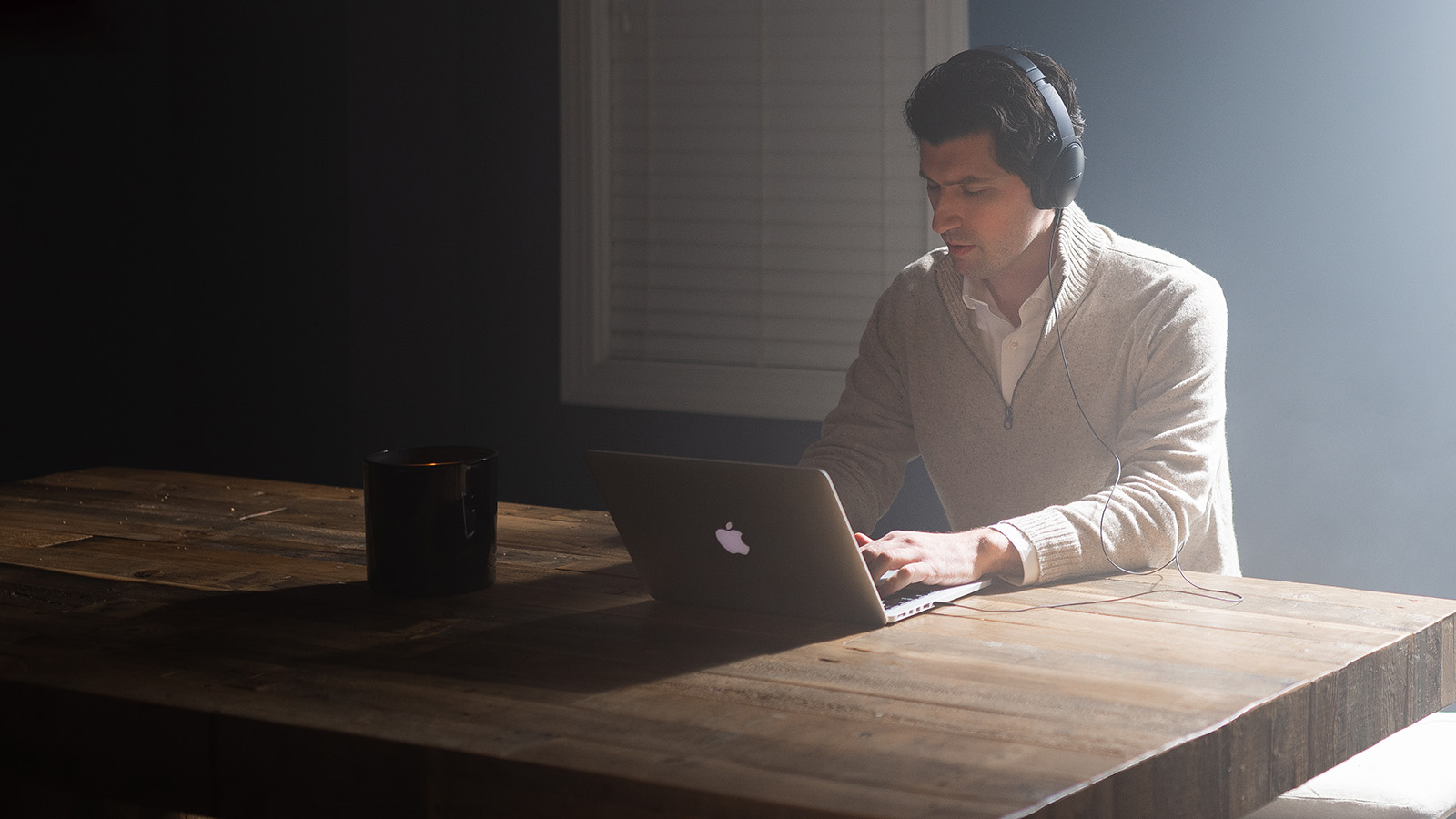
“Imagine if I’d gotten an email and it said, ‘Between 00:05:33 and 00:05:34 cut to the other camera angle.’ There might be five different musical notes and it would have been a disaster to have to do that 80 or 100 times from an email,” he says. “So to be able to have Andrew just go in and comment timecode-specifically, and then to import them into the cut and see it right in the timeline was amazing. It was always spot on.”
It was also easy for them to share cuts with Murray over Frame.io. “If we sent a link to Bill, he didn’t have to start an account. He could just click on the link and then, boom, he’s got it.”
If we sent a link to Bill, he didn’t have to start an account. He could just click on the link and then, boom, he’s got it.
At long last
Leading up to the premiere, the team needed to create screeners for potential distributors and the press, as well. “Frame.io gave us the ability to just duplicate the film, create a new link with a password and expiration, and send it to anyone who needed to see it,” Andrew says.
Jon recalls one instance where he needed to send a cut to Andrew and was able to do so directly from his phone. “We were working on this project for so long, and I wasn’t at my workstation. Andrew needed a screener with a different name. Instead of having to rush back to my house, I had the Frame.io app on my phone. I can’t tell you how many times the iPhone app has saved me on the weekends or whatever.”
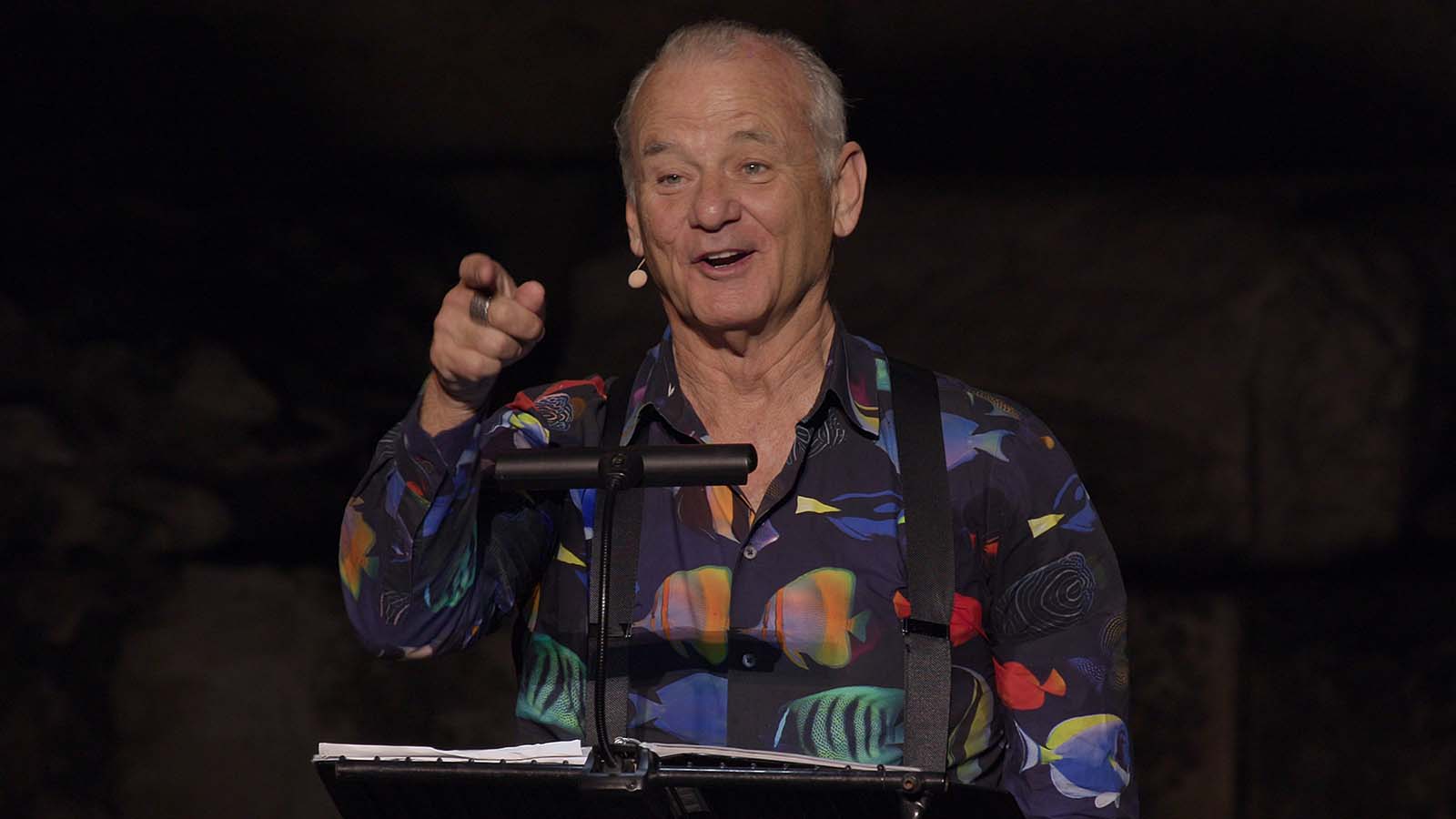
Three years after the Acropolis performance, the film was finally ready to debut at Cannes in July of 202l. As you might imagine, it was hardly an ordinary premiere. Murray and the trio of musicians took to the stage after the film and treated the audience to several musical numbers. He finished with a rousing version of “Aline,” a French classic that’s featured in that other film Murray was at Cannes to promote—Wes Anderson’s The French Dispatch.
New Worlds: The Cradle of Civilization finally has its theatrical release. But even with its lengthy journey, there’s a certain timeliness to it now, as we look back on more than two years of a pandemic. The Acropolis still stands after 2,000 years. The music of Bach endures, as do the writings of Hemingway, Twain, and Cooper. And we are still here to appreciate the artistry that humans create.
Andrew sums up the experience for the team. “Each step in the process has been extraordinary and fulfilling. They put together a beautiful show, and I’m very grateful that Bill asked me to document this project and allowed me to bring in collaborators whom I trust and value as friends, as well.”
As always, we likewise remain grateful to the filmmakers and friends of Frame.io and Adobe, who give us the privilege of telling the stories of how they create their art.

